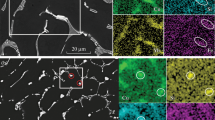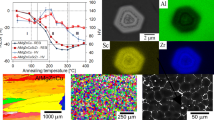Abstract
In order to obtain aluminium-based superconducting alloys including finely dispersed lead or Pb-Bi particles, the application of the melt-quenching technique has been tried for Al-Pb, Al-Si-Pb and Al-Si-Pb-Bi alloys containing immiscible elements such as lead and bismuth. It has been found to result in the preparation of superconducting materials consisting of fcc Pb or h c p ε(Pb-Bi) particles dispersed finely and densely in the aluminium-based matrix in each composition range below about 2 at % Pb for Al-Pb alloys and 5 at % Pb or (Pb + Bi) for (Al0.9 Si0.1)100−x Pb x and (Al0.9Si0.1)100−x (Pb0.6Bi0.4) x alloys. The particle size and interparticle distance were ∼ 40 nm and 40 to 100 nm, respectively, within the grains, and ∼ 100 nm and below ∼ 30 nm, respectively, at the grain boundaries for the lead phase in Al98 Pb2 alloy. Particle size was ∼ 15 to 60 nm and interpartide distance 30 to 60 nm for the Pb- Bi phase in (Al0.9 Si0.1)95(Pb0.6 Bi0.4)5 Transition temperature,T c was 4.16 K for Al98Pb2, 3.94K for (Al0.9Si0.1)95 Pb5 and 7.75 K for (Al0.9Si0.1)95(Pb0.6Bi0.4)5. The upper critical magnetic field,H c2, and critical current density,J c, for (Al0.9Si0.1)95(Pb0.6Bi0.4)5 were 0.22 T at 4.2 K and 1.67 × 107 Am−2atzeroappliedheld and 4.2 K. The appearance of the superconductivity for the aluminium -based alloys was interpreted as due to the formation of superconducting percolation path along the tangled dislocations, sub-boundaries and/or grain boundaries where Pb and Pb-Bi phases precipitated preferentially.
Similar content being viewed by others
References
A. Inoue, M. Oguchi, Y. Harakawa, K. Matsuzaki, N. Yang andT. Masumoto, Japanese Patent Applications, Nos. 59-164693, 59-164694 and 59-164695 (1984).
A. Inoue, M. Oguchi, K. Matsuzaki, T. Ogashiwa andT. Masumoto,Sci. Rep. Res. Inst. Tohoku Univ. A-33 (1986) 111.
M. Hansen, “Constitution of Binary Alloys”, (McGrawHill, New York, 1958) pp. 245, 1028, 1084.
E. R. Jette andE. B. Gebert,J. Chem. Phys. 1 (1933) 735.
A. Inoue, M. Oguchi, K. Matsuzaki, Y. Harakawa andT. Masumoto,J. Mater. Sci. 21 (1986) 260.
A. Inoue, M. Oguchi, K. Matsuzaki andT. Masumoto,Int. J. Rapid Solidification 1 (1984–5) 273.
K. Matsuzaki, A. Inoue, M. Oguchi, N. Toyota andT. Masumoto ibid. in press.
W. B. Pearson, Handbook of Lattice Spacings and Structures of Metals and Alloys (Pergamon, London, 1958) p. 124, 127.
H. Jones,Aluminum 54 (1978) 274.
D. Solomon andW. Morris,Phil. Mag. 11 (1931) 1090.
H. Hofe andH. Hanemann,Z. Metallkde. 32 (1940) 112.
C. Suryanarayana andT. R. Anantharaman,Solid State Commun. 12 (1973) 87.
R. W. Roberts, Properties of Selected Superconductive Materials, NBS Technical Note 983, Supplement, (US Department of Commerce, Washington, 1978).
T. Otsuka, Ferroelectrics and Superconductors, (Japan Institute of Metals, Sendai, 1973) p. 131.
C. Kittel, Introduction to Solid State Physics, 5th edn. (John Wiley, New York, 1976) p. 154.
A. B. Pippard,Proc. Roy. Soc. (Lond) A216 (1953) 547.
G. Deutscher andD. G. de Gennes, Superconductivity, Vol. 2, edited by R. R. Parks (Marcel Dekker, New York, 1969) p. 1005.
W. Silvert andA. Singh,Phys. Rev. Lett. 28 (1972) 222.
M. Lyon andG. Zepp,Can. J. Phys. 55 (1977) 55.
W. Silvert,Solid State Commun. 14 (1974) 635.
W. Silvert andL. N. Cooper,Phys. Rev. 141 (1966) 336.
Author information
Authors and Affiliations
Rights and permissions
About this article
Cite this article
Inoue, A., Yano, N., Matsuzaki, K. et al. Microstructure and superconducting properties of melt-quenched insoluble Al-Pb and Al-Pb-Bi alloys. J Mater Sci 22, 123–131 (1987). https://doi.org/10.1007/BF01160560
Received:
Accepted:
Issue Date:
DOI: https://doi.org/10.1007/BF01160560




